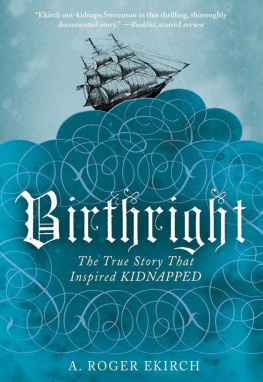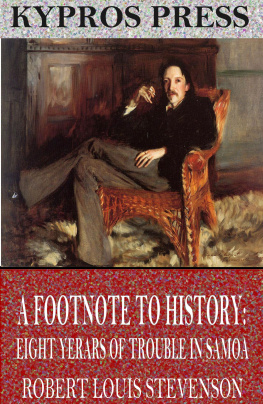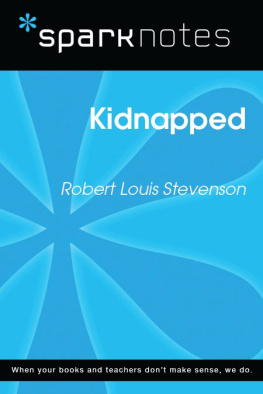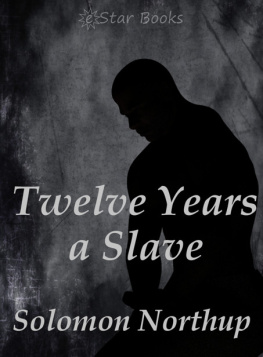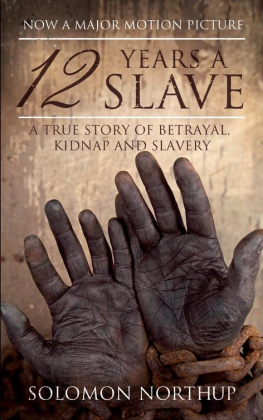A LSO BY A. R OGER E KIRCH
BIRTHRIGHT
The True Story That Inspired Kidnapped
A. ROGER EKIRCH

W. W. NORTON & COMPANY
New York London
Copyright 2010 by A. Roger Ekirch
All rights reserved
For information about permission to reproduce selections from this book,
write to Permissions, W. W. Norton & Company, Inc.,
500 Fifth Avenue, New York, NY 10110
Library of Congress Cataloging-in-Publication Data
Ekirch, A. Roger, 1950
Birthright: the true story that inspired Kidnapped / A. Roger Ekirch.
p. cm.
Includes bibliographical references.
ISBN: 978-0-393-06615-9
1. Annesley, James, 17151760. 2. Kidnapping victimsIrelandBiography.
3. KidnappingIrelandHistory18th century. 4. Trials (Kidnapping)
IrelandHistory18th century. I. Title.
HV6604.I72A564 2010
364.15'4092dc22
[B]
2009033194
W. W. Norton & Company, Inc.
500 Fifth Avenue, New York, N.Y. 10110
www.wwnorton.com
W. W. Norton & Company Ltd.
Castle House, 75/76 Wells Street, London W1T 3QT
For Alice,
Alexandra, Sheldon, and Christian,
but for whom
The neglect of one child may be the destruction
of a long succession of families.
A.M., Dublin Weekly Journal,
October 16, 1725
MAPS
ILLUSTRATIONS
ACKNOWLEDGMENTS
I n the course of my research, I became indebted to numerous institutions and their staffs on both sides of the Atlantic. In Dublin, I wish to thank the National Library of Ireland; the Library of Trinity College, Dublin; the Pearse Street Library; and Philomena Brant at the Registry of Deeds. Deirdre OConnell performed preliminary research for me at the National Library of Ireland, and Stuart Kinsella, a historian at Christ Church, graciously answered my questions about the Cathedral. I am grateful to the Public Record Office of Northern Ireland in Belfast; the Record Offices of Oxfordshire, Cheshire and Chester, Lancashire, North Devon, and Devon; Jennie Lynch at the Parliamentary Archives in Westminster (formerly the House of Lords Record Office); the Senate House Library at the University of London; the National Archives at Kew (in particular James Ross and Ian Strawbridge); and the Manuscripts Department of the British Library in London. In the United States, thanks are due to the staffs of the Houghton and Widener Libraries at Harvard University; the Library of Congress; Alderman Library at the University of Virginia; the Delaware State Archives; and Newman Library at Virginia Tech, most of all the staff of the Interlibrary Loan Department for their unfailing perseverance on my behalf. For supporting this project with both grants and academic leave, I am indebted to the Department of History and the College of Liberal Arts and Human Sciences at Virginia Tech.
For assistance in providing access to the books maps and illustrations, I wish to express my gratitude to Mire N Chonallin and Colette Dayly at the National Library of Ireland; Paul Ferguson and Rachel Moss at the Library of Trinity College, Dublin; Camille Lynch at the National Gallery of Ireland; Donnacha OMaille of Old Irish Maps; Matthew Bailey at the National Portrait Gallery in London; Stephanie Fawcett at the Victoria and Albert Museum; Gudrun Muller at the National Maritime Museum; Jane Cunningham at the Courtauld Institute of Art; William Laffan; and Susan I. Newton at the Winterthur Museum. The Rev. David Gatliffe, rector of St. Margarets, Lee, kindly photographed the old churchyard where James Annesley and his son are buried. He has my deep appreciation.
I would like to pay special tribute to the Conway family of Dunmain House, who warmly invited me into their historic home. It was a grand pleasure to spend an afternoon with James and Ann, their daughter Elizabeth, and her children, Charlotte and John Robert. Thanks also to Thomas OConnor for showing me the surrounding countryside and to the boys of Ringsend with whom I shared a Zodiac in Dublin Bay on a brilliant July day.
For reading an early draft of the manuscript, I am grateful to Kevin Whelan, Toby Barnard, Sean Connolly, and Neal Garnham. All were extremely generous in sharing their deep understanding of Irish history and culture. My nephew Jason Chung took time from the campaign trail to help with proofreading. Jackie Hill supplied important information on the Giffard family manuscripts. I am also indebted to Lord Wilson of Tillyorn and Lord Lloyd of Berwick for their valuable counsel. The assistance of Linda Fountaine, Janet Francis, Susan Archer, Jesse Sherman, Kathy McIntyre, Clara Enriquez, and Shenna Stamper was greatly appreciated. Lucky Garvin and my two brothers-in-law, David and Don Lee, contributed their medical knowledge, whereas my sister Caryl, besides lending her advice, was good enough to accompany me on a hike through patches of Mill Creek Hundred in northern Delaware.
I could not wish for a more splendid agent than Georges Borchardt, who together with Anne and Valerie Borchardt, has been unflagging in his support. My editor, Alane Salierno Mason, has, as always, been an exceptional source of wisdom and good sense. She and so many others at Norton, including Denise Scarfi and Alex Cuadros, have my profound gratitudeas does Allegra Huston for her sensitive reading of the manuscript.
PREFACE
W icked uncle, kidnapped heir, bastards, sudden death. Very gratifying, pronounced the young novelist Patrick OBrian in 1945 on reading a contemporary sketch of James Annesleys life. The presumptive heir to five aristocratic titles and sprawling estates in Ireland, England, and Wales, Annesley was kidnapped from Dublin in 1728 at the age of twelve and shipped by his uncle to America. Only after twelve more years, as a servant in the backwoods of northern Delaware, did he successfully return to Ireland to bring his uncle, the Earl of Anglesea, to justice in one of the most sensational trials of the eighteenth century.
But was Jemmy, in fact, scion of the house of Annesley or, as his enemies insisted, the bastard son of a common house servant? And how, in an age bereft of paternity tests, fingerprint records, and DNA laboratories, could a prodigal who had been missing for over a decade hope to reclaim his birthright in a court of law?
This extraordinary tale has over the centuries inspired at least five novels, including Kidnapped (1886) by Robert Louis Stevenson and Sir Walter Scotts Guy Mannering (1815). Set either in Ireland or Scotland, these narratives have invariably revolved around the dramatic abduction of a young heir for the purpose not of extorting ransom but of usurping the lads patrimony.
The real-life ordeal of Jemmy Annesley is even more incredible, though historians, curiously, have all but ignored his strange saga. The truth is that it is both.
The Annesleys, an English family who during the course of the 1600s achieved wealth and fame in Ireland on a grand scale, were scarcely the only noble house in either kingdom racked by internal discord. By the eighteenth century, many family dynasties, once united by bonds of kinship and clientage, had given way to nuclear households comprising parents, children, and a small ring of close relatives. Legal quarrels, especially rival claims over inheritance, were not uncommon among distant relations. When kinsfolk are
But the Annesleys fought the bulk of their battles at close quarters. The ferocity of their clashesover rank and wealth, rather than theology or political dogmacut to the familys very core, pitting husband against wife, father against son, and brother against brother. Jemmys abduction by his Uncle Dick was merely the most brazen act of treachery, neither the first nor, surely, the final breach of trust. Ultimately, this is a story about betrayal and lossbut also about endurance, survival, and redemption. Despite its English origins, it is, at its heart, an Irish tale.

